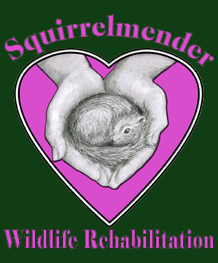
- Home
- Helping Wildlife
- Important Rescue Info!
- Found A Baby Squirrel?
- Found A Juvenile Squirrel
- Found Adult Squirrel
- How to Rescue Wildlife
- Handling Wildlife
- What About Rabies
- Dead Wildlife
- Find a Rehabber
- Make a Donation
Every dollar donated to Squirrelmender Wildlife Rehabilitation goes directly to the care of wildlife providing food, medical supplies and housing for the hundreds of animals that come through here.
Donate NOW
Squirrelmender Wildlife Rehabilitation
330 Charro AvenueAddress
Thousand Oaks, CA
91320
A tax-exempt, non-profit permitted by the California Department of Fish and Game.
Phone:805-498-8653
E-mail:
We also accept online donations through Network for Good.

Thousand Oaks, CA 91320
phone: 805-498-8653
cell: 805-338-0481
How To Rescue Wildlife
|
Except when dealing with adult mammals or very large birds, you should contain the animal, and transport it to a licensed rehabilitator in your area. Both mammals and birds can carry zoonotic diseases (diseases that can be transmitted from animals to humans) so it is wise to take precautions. Zoonotic diseases are not easily transmitted as long as common sense is used (like wearing gloves and long sleeves or handling the animal with a towel). A Word About Animal ControlNo two animal control jurisdictions do the same thing; differences are primarily because of funding. Most (but not all) will pick up injured wildlife if it is contained, but please refer to animal control for pickup as a last resort because it can cause a delay getting the animal to a rehabilitator, and sometimes in addition the rehabilitator will have to find another driver to pick the animal up at the shelter. Some will rescue animals that are not contained. Some have no wildlife programs at all, and will not respond to wildlife calls unless there is a threat to public safety. Capture and HandlingAll baby animals should be handled with at least thin latex gloves or garden gloves and adults with heavy duty gloves because of the possibility of parasites or diseases being transmitted. Although birds have no sense of smell, mammals have a keen sense of smell and it is wise to avoid human scent if renesting is being attempted. Hands should always be washed after handling animals. All animals, except young babies, will perceive the human rescuer as a predator and will suffer considerable stress during the rescue process. Small birds and mammals may be handled by throwing a light towel (hand or dishtowel) over them. If the bird is stressed by your approach, the towel can be held in front of you as a cover until it is thrown over the animal.. Once the animal is in the dark and remains there, it will become much calmer. Adult and juvenile mammals will bite if cornered. Care must be taken when capturing them. A bite from a frightened mammal may mean a death sentence for it as it may need to be tested for rabies. To capture larger animals and birds, use a large, heavy towel such as a beach towel folded double or triple, or a padded jacket. Animals will not be able to bite through the towel, and generally will be calmed when placed in a dark environment. In many circumstances, dampening the towel first adds weight and makes it even more secure when placed over the animal. If a baby is without feathers/fur, or is cold, provide it with immediate warmth by wrapping it loosely in some soft material (without strings) and placing it beside your throat near the collarbone until it is warmer. Then it can be placed in a warm place (see containment instructions) until it can be taken to a rehabilitator. Containment1. Place the animal in a box or plastic pet carrier sized so that the animal is comfortable but doesn't have room to turn around or hurt itself. Line the box with a towel or paper towels to keep the animal from sliding. The box must be covered (punch air holes from the inside if necessary) and the lid taped on if there is a rabbit or active animal inside. (A rabbit can jump, pushing the top off a box, and injure itself further or escape). Birds can be carried in paper bags or boxes. Birds should never be placed in a metal bird cage, especially if they have a broken wing, because of the possibility of wing or feather damage. If a bird cannot stand up, make a donut with a small towel and prop the bird up inside. Do not put water inside the box, particularly during transport, as the animal may fall into it and drown. 2. Keep the animal warm, covered, and in dark quiet surroundings. Cover a baby mammal with several T-shirts, towels, or an old sheet. For an injured animal or a baby without feathers/fur, or a cold animal, place a small jar or ziplock bag filled with warm water and wrapped in several layers of socks inside the box, beside it. The layered materials will quickly create a warm environment. If a heating pad is used, it should be placed so that it is only half under the animal (so that if it overheats the animal can get away from the heat source). 3. Handle the animal as little as possible. Do not disturb it or repeatedly uncover and check on it. If you must handle it, all movements should be performed slowly. Try to cover the animal before attempting to pick it up. Scoop up the animal; do not dangle the lower body. 4. Keep children, cats, and dogs away. 5. Do not give food or drink unless directed to by a rehabilitator. Animals may be in shock and food/water given when in shock can kill it. Food given to a dehydrated animal is also dangerous. Also, food and water given improperly to an animal or bird can choke it or give it pneumonia. TransportFirst, locate your nearest licensed wildlife rehabilitator, and contact them to describe your situations. Most rehabilitators (especially during spring and summer baby seasons) have their hands full doing animal care, and will appreciate your assistance in getting the animal to them if needed. If you cannot transport the animal yourself you may ask for help from a neighbor or friend. Delays of more than 2 or 3 hours are not advisable. This information is posted with the permission of its authors
- the Wildlife Rescue League, Falls Church, VA
|
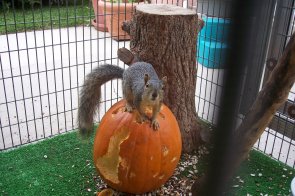 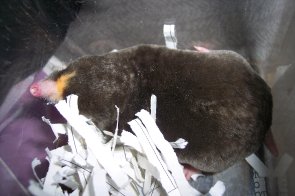
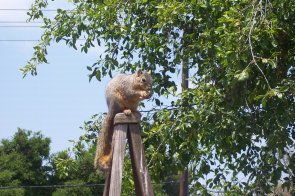 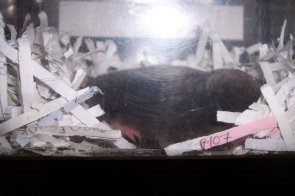 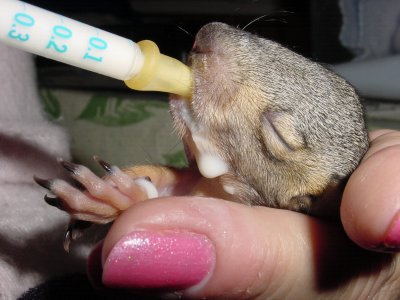  |